Treasure Island: Exploring The Sights, Sounds And Delicacies Of Tasmania
Stunning coastlines, national parks galore and out-of-this-world gourmet food makes Tasmania a truly beautiful place to visit. Kenneth Goh finds life beyond the malls to connect with Mother Nature, and breathe the freshest air in the world
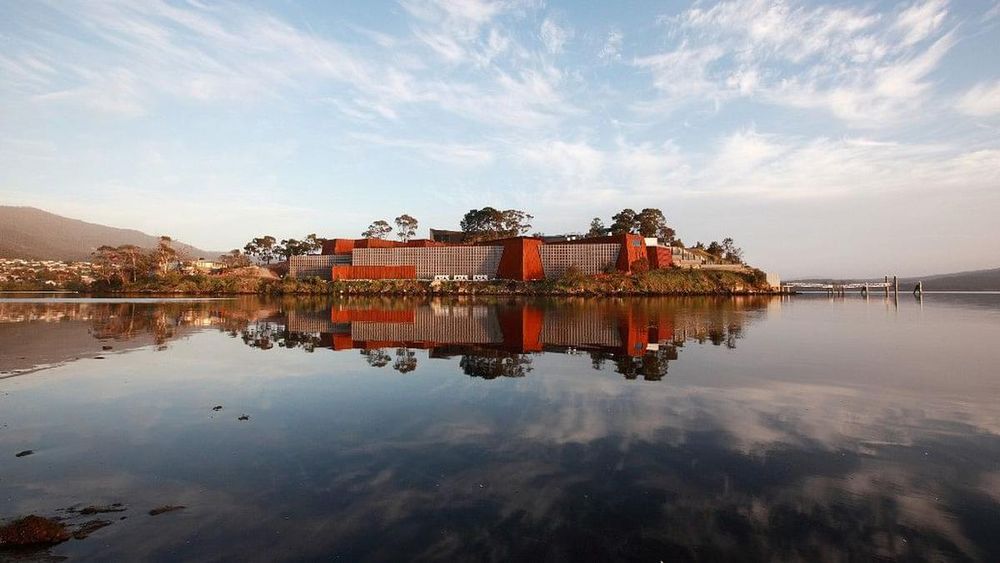
I could have been admiring azalea shrubs in bloom or breathing in the fresh sea breeze from the wharf. Instead I am listening to Lucy, the storyteller from MACq 01 Hotel in Hobart. Lucy, a bright-eyed local girl, is regaling me with fascinating stories about the early immigrants to Tasmania, many of whom were Irish women and their kids, kept incarcerated and confined in quarters close to where MACq 01 now stands. Outside the side entrance to the hotel are life-sized sculptures of these early settlers, testament to the local area’s history.
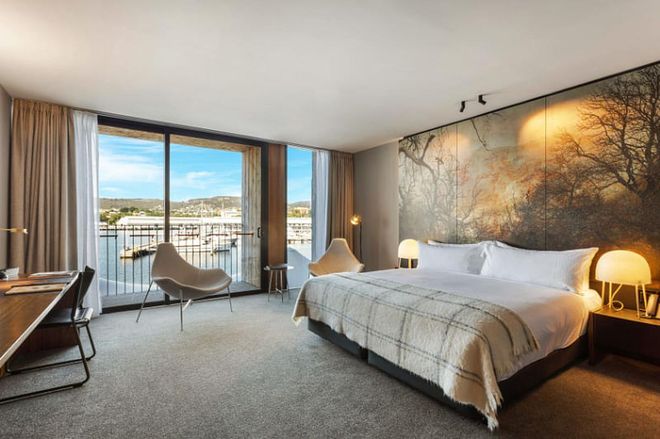
The expansive Rodney Croome suite with its own terrace views. Photo: MACq01, Adam Gibson
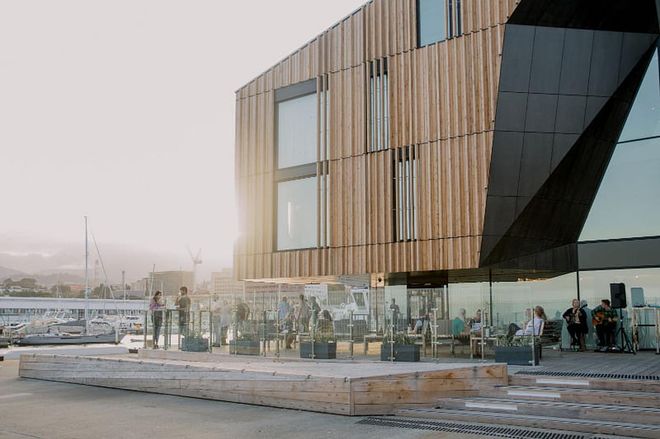
Promenade views of MACq 01 from the harbour at Hobart. Photo: MACq01, Rosie Hastie
Welcome to the MACq 01 Hotel in Hobart, housed in a deliciously modern building in the historic old wharf area. The hotel’s storytelling tours are complimentary for guests. As Lucy unveils the hidden haunts and hangouts of former convict immigrants, she tells me to take a look through the retro viewfinder, distributed to each person attending the tour, for a glimpse of what life was like then. Single immigrant women were often employed as domestic servants while skilled men with young children were given jobs as mechanics and agricultural labourers.
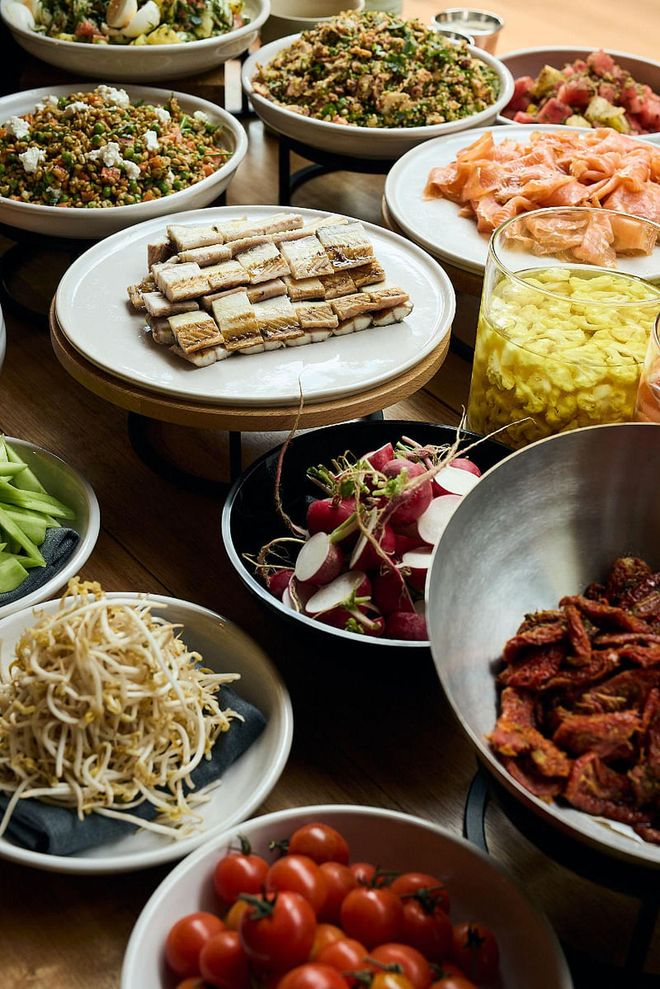
A smorgasbord of delicious Tasmanian offerings at Peppina Sims at The Tasman. Photo: Peppina Sims
In a similar vein, all 114 rooms and suites at the hotel are named after indigenous people, explorers, convicts and heroes. Each character is represented with a unique illustration on the door, with artefacts relating to that character displayed in the room. Heritage and history permeates everything, from the cocktails served at the hotel’s Story Bar, named after colourful local characters; to the menu at the hotel’s Old Wharf Restaurant, inspired by the early industries of whaling and farming. The reception lounge centres around an open and cosy fireplace reflecting Tassie’s (local slang for Tasmania) indigenous heritage with displays of extraordinary artefacts dating centuries back. Even the hotel’s two lifts are storytelling elevators—instead of the usual ersatz music, they tell stories of the local area.
It’s all about location, location and location, and you can’t get a better address than at MACq 01. The hotel occupies some of the best real estate in Hobart, with front-row seats to the vast River Derwent, against the backdrop of the snow-tipped Mount Wellington. This was once the working area of Hunter Island, surrounded by fishing boats and convict-built sandstone warehouses, and connected to Sullivan’s Cove by a narrow causeway. Today, the precinct is known as Hunter Street and the neighbourhood boasts some of Hobart’s renowned restaurants and cafes. The weekend Salamanca Market is a short walk away. If you fancy a quick snack on the wharf, there’s a popular fish and chips shop selling excellent grilled salmon from the Huon Valley.
Related article: In Conversation With British-Australian Singer And Songwriter Ruel
I stayed at Rodney Croome suite, on the top level, a 60sqm premium waterfront suite with a huge terrace and a view to die for. It overlooks the seafront and fishing vessels, and has been carefully designed to reflect a “relaxed luxury’’ with comfy sofas; a king bed with Egyptian cotton sheets; and a generous-sized bathroom with two wash basins, a bath and separate rain shower; spacious, walk-in wardrobes, and underfloor heating— what bliss. The cool hotel also serves a yummy breakfast of baked eggs, a hint of the many wonderful meals to come.
Tasmania is world renowned for its pristine waters, a coastline that brims with deep sea fish, abalone, oysters, sea urchin, rolling hills filled with cellar doors and the freshest meats and poultry. It’s truly an island blessed by the gods. Top chefs abound and the food and wine is second to none. I’m here for five days and I can see my waistline already expanding as I drift from one welcoming restaurant to the next, dining on incredible food that’s often sourced directly from farms, local growers and fishermen. For all the small-town quaintness, the local palate is incredibly sophisticated. Take dinner at The Tasman: Fresh Tasmanian produce served in a casual yet chic setting, the local seafood, free-range meats, char grilled steaks, seasonal vegetables and a wide range of cool climate wines made this such a refreshingly unpretentious dinner, with excellent service to boot. The place was buzzing even for a weekday night, which is testament to the quality of the food.
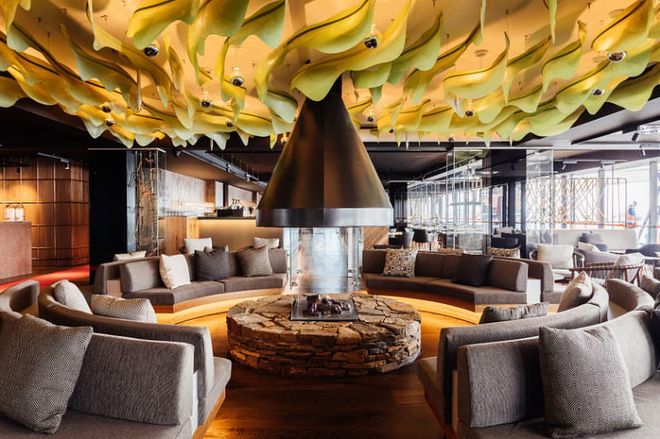
The central fireplace at MACq 01. Photo: Adam Gibson
The next morning took me to the famous Museum of Old and New Art (MONA). A must-visit attraction created by ultra-rich professional gambler, David Walsh to help him (in his words) “bang above [his] weight”, it’s a mind-boggling journey into the world of the eccentric owner. It is the largest privately-funded museum in the Southern Hemisphere, and houses ancient, modern and contemporary art. Most of the museum is underground and spread out through a subterranean complex of tunnels and chambers dug out from the sandstone bedrock of the Berriedale peninsula. One of the most spectacular exhibits is by Chinese artist, Ai Weiwei, named “The White House”. The raw stone walls of the cavernous chamber dramatically frame the white-washed wooden bones of a Qing dynasty house, and crystal balls float the sculpture towards the skylight. Outside, there are dramatic spaces to provide shelter while you walk around the pretty grounds—a camera is a must to capture all these elements of sun, sea and incredible architecture.
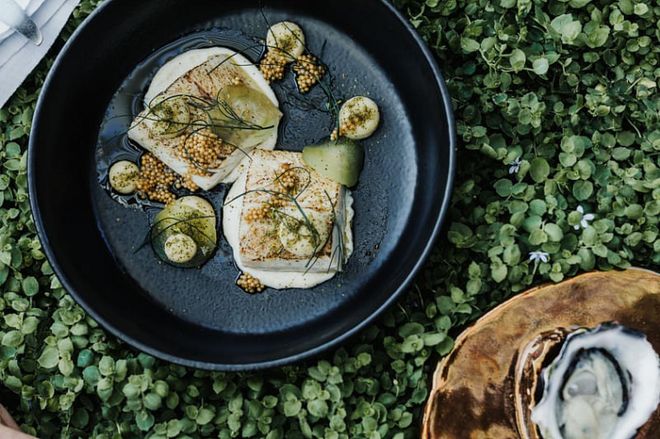
The delicious seafood at The Source. Photo: Adam Gibson
After a good three hours at the museum, my rumbling tummy tells me it’s time for a quick stop for lunch. The Source restaurant, located up the hill from the museum and boasting sweeping views and moss-covered tables, is billed as “a temple to seasonal Tasmanian dining”. My favourite dish, surprisingly, was kangaroo tartare seasoned with herbs and lots of pepper which was so good, I went for seconds.

A bird’s eye view of Freycinet Lodge at Coles Bay. Photo: Courtesy of RACT Destinations
After lunch, I got into the car and zipped as fast as I could down to Freycinet Lodge down at Coles Bay. It’s a serious three-hour car journey, but the views along the way are truly spectacular. This is the one island you can see where the sky touches the rolling hills and far-off ocean—an incredible meeting of elements that you simply can’t see anywhere else. The country roads are very well paved and quite empty, so you can easily self-drive. If time allows, take a slower, more leisurely trip down to Coles Bay and stop for picture-taking or just to soak in the views. But because I travelled during winter, it’s not recommended to drive after dusk, so I hit the pedal pretty hard (within limits) to ensure I got there before dark.
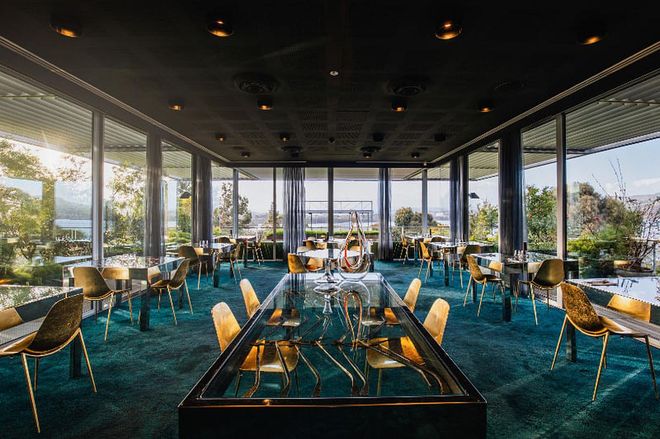
The dining room at The Source. Photo: MONA, Jesse Hunniford
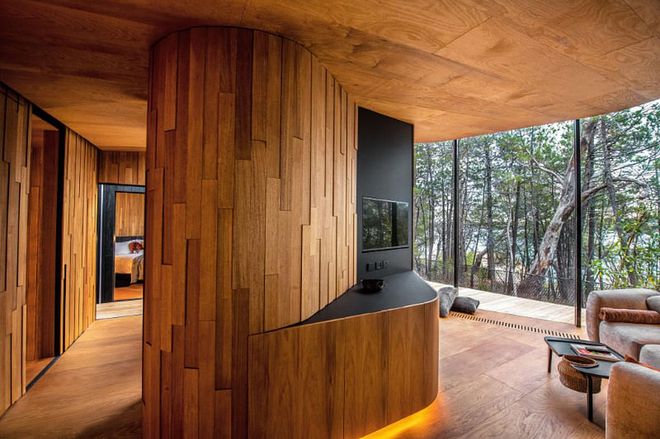
The all-wooden Coastal Pavilion at Freycinet Lodge. Photo: Courtesy of RACT Destinations
With a spectacular waterfront location at the foot of the Hazards, just inside Freycinet National Park, Freycinet Lodge makes a great base to explore the Freycinet peninsula. Chic yet comfortable, the Lodge is proof that communing with nature does not have to mean roughing it. You can relax and rejuvenate while experiencing the best of what Mother Nature has to offer. I stayed at the new Coastal Pavilions that offers an immersive connection to the natural surroundings of Freycinet National Park. The all-wooden pavilion truly opens up in the day time when the glass ceilings let in ample sunshine and light. Built strategically inside the woods (with the coast visible from the large outdoor terrace) it’s an oasis of calm with Swiss cabin vibes.
Related article: EIC Kenneth Goh Shares Some Poignant Moments With His Mum When He Visited Her In Australia
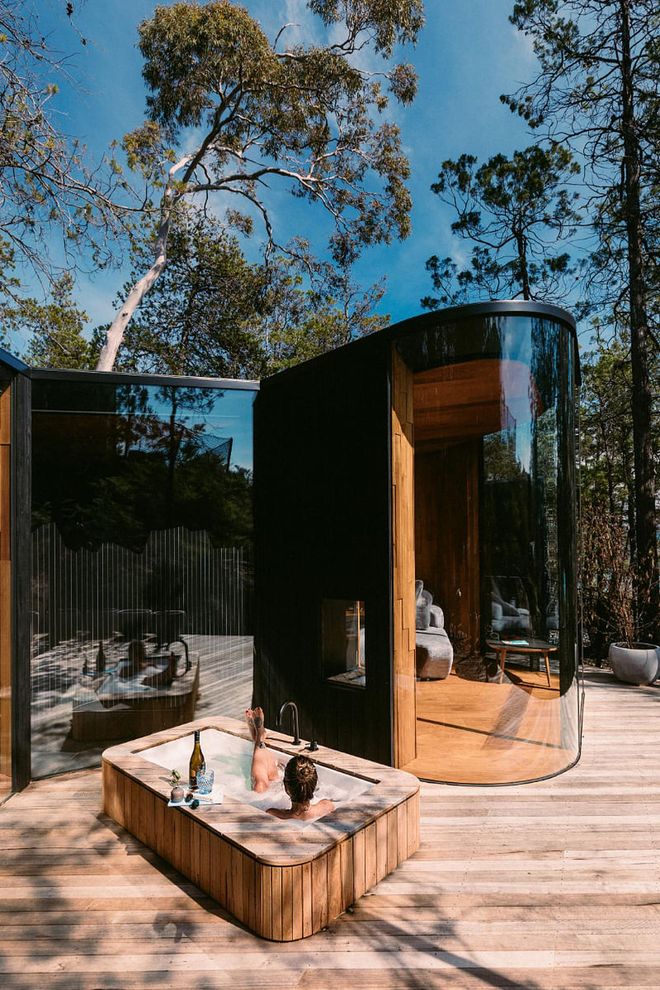
Luxuriate in your own private bath on the terrace of the Coastal Pavilion. Photo: Melissa Findley
I took a brisk morning stroll along the wooden paths that join each pavilion to the main building where all the meals are served. It’s also the perfect spot to check out the 180-degree views of the expansive coast. After walking down a path from the main dining hall to get to the pier, I took a cruise along the spectacular coastline of Freycinet National Park from Coles Bay to Wineglass Bay. I saw stunning granite coastlines dotted with active waterfalls, including the dramatic pink peaks of the Hazards range. Wineglass Bay has a far more gruesome history than the white sandy shores profess. In the early 1800s, there were whalers and sealers working and living in the area. The whalers would set out in small boats from the shore to chase and harpoon passing whales, before towing them back to shore to be butchered. Today, this serene spot is perfect to moor the boat while I tuck into lunch. My hunger pangs were satiated with halva and fruit for morning tea, and for lunch, a ploughman’s style platter of hot and cold salmon, smoked chicken breast, salads, vegan cheese and dairy options, plus fresh local bread and shucked local oysters.
I left super early the next morning for my three-hour drive back to Hobart. Once in Hobart, I went down to Battery Point to see some great examples of this city’s best preserved homes and architecture. I did a loop in Runnymede Street, at Arthur Circus Park, Australia’s only residential circular street, and saw some of its gorgeous Georgian architecture. Then I headed out to Hampden Road and stopped at bakery institution Jackman & McRoss (built in the 1840s) for a pastry and coffee, and ended with a final wander into Annicks Antiques across the road before driving to the airport to catch my flight back home. Exhausted but thoroughly satisfied, this trip has been heaven for the mind, body and soul—now I just have to hit the gym daily and clamp my mouth shut for the next six months.